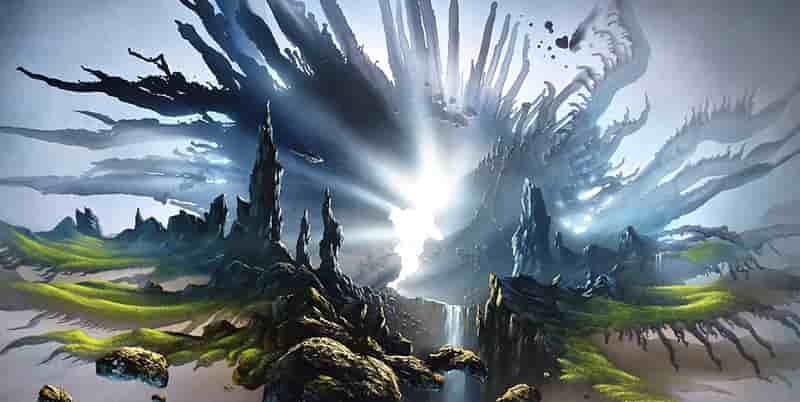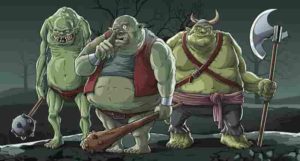In DnD 5e, play a wood elf for these tropes and characteristics:
- Apex hunter—Ranger or Druid Circle of the Moon
- Forest Keeper—Druid Circle of Land: Forest or Swamp
- Ninja—Rogue or Monk
- Master Swordsman—Ranger or Battlemaster
The wood elf gains a +2 Dexterity/+1Wisdom bonus. So, I should lean into classes that utilize these ability scores. A few other wood elf traits to consider are:
- Elven Weapon Training: Proficiency with longswords, short swords, longbows and short bows.
- Fleet of Foot: Movement speed is 35 feet—keeping just out of range of enemies in many cases.
- Mask of the Wild: I can attempt to hide when I’m lightly obscured by natural elements: snow, foliage, fog, etc.
The wood elf race is inherently connected with nature and magic. Coming from the feywild, they are naturally long-lived like their cousins. However, the wood elf variant tends to be more down-to-earth than a high elf or drow. We could think of the wood elf as the everyman elf—the guy next door who’s laid back and somehow good at everything.
Unlike their cousins, wood elves are explorers and lovers of adventure. They often trade and get along with other races, though they still may carry elven traits of aloofness or arrogance. We can play the wood elf as fun-loving, nonchalant, adventurous and tricksy. Remember, they aren’t totally human in behavior—coming from an alien dimension.
Before we dive in, you can try out your wood elf in an my original pirate adventure, Dead Man’s Tale. Click here or below to learn more.
Apex hunter—Ranger or Druid Circle of the Moon
The wood elf hunter is a staple in elven lore. These people of the forest use speed, dexterity and stealth to stop threats from reaching their villages deep in the wild. Who better to master guerilla hunting tactics than the masters of the woodlands themselves? Though the most obvious build for this classic trope is a bow-hunting ranger, DnD 5e offers an interesting druid option for primal shapeshifting.
Any subclass of ranger could fit this trope, paired with a longbow and Archery Fighting Style. Consider the classic Hunter subclass and gain devastating extra damage with a bow shot. The Colossus Slayer ability that comes with the Hunter grants an extra 1d8 damage once my prey loses any HP. Also, ranger spells like hail of thorns, cordon of arrows and hunter’s mark give fantastic options with ranged weapons. Check out a build for this character here.
Looking outside the obvious, I could use a Circle of the Moon druid to tap into primal magic and hunt my foes with enhanced senses. This circle allows me to rapidly shapeshift as a bonus action—taking advantage of my high Initiative (Dexterity) to pounce in combat. Plus, I’ll be able to shift into much stronger creatures than other druids. I’m thinking choices like giant hyena, giant spider and giant poisonous snake could be fun to use at early levels. Check out a build for this character here.
Forest Keeper—Druid Circle of Land: Forest or Swamp
Because wood elves are connected with the forest, some characters should directly interact with the surrounding plant life. This druid is our wood elf spellcaster, an area-of-effect specialist who mixes in healing and helpful spells for the party. For this build, we’ll lean into Wisdom as our highest score while dodging enemies with Dexterity, gaining additional spells from Circle of the Land.
Related Posts:
Scary Fairies: Mythology Explained
| Princess Mononoke Wolves and Forest Spirits: What They Mean
|
Using the forest build from Circle of the Land, I’ll add spells like barkskin, spider climb, plant growth and call lightning to my spells known. I’ll fill in my other spells with cure wounds, create food and water and druidcraft to play with my forest surroundings. Entangling vines and hold person can utilize tree branches, roots and vines to ensnare foes. Plus, I can still shapeshift into beasts within my realm—which has plenty of wolves, bears and badgers for me to use.
However, I could put an interesting twist on this druid character with the swamp build. Now, area-of-effect spells look more like stinking cloud and darkness. Add in Melf’s acid arrow for damage and water walk to move through the boggy wetlands, and this character sticks out. This is a good way to flip this druid archetype on its head for something less grand than mountains and forests. I could even give this character a nefarious edge or make him weird and obsessed with fungus or bugs.
Ninja—Rogue or Monk
With our most obvious choices out of the way, my next favorite way to play wood elf is to lean into their martial and stealth skills for a deadly assassin. A wood elf’s speed, Dexterity, affinity with the longbow, and Mask of the Wild can all be used to great effect as a ninja. In fact, we have several ways to build this character.
As a rogue assassin, I could leverage my high Dexterity and proficiency with the longbow to take out targets. Assassins get the best benefits when they out-speed foes in combat or are able to attack from a hidden position. Good thing wood elves gain a fat Dexterity bonus and the ability to hide in slight natural coverings.
A monk build would also benefit from my natural Dexterity. However, I would gain advantages with my Wisdom score as well. Add both scores together, and my wood elf will have Unarmored Defense down. I could take the Way of Shadows to enhance my natural stealth, gaining the ability to cast darkness and pass without trace with ki points. Plus, I’m excited to wield a short sword and throw down Flurry of Blows, Step of the Wind and Patient Defense.
Check out more ninja builds here.
Master Swordsman—Ranger or Battlemaster
I could also use the wood elf’s Dexterity and Wisdom to create a legendary, Dex-based swordsman using a ranger or fighter class. Naturally, I’ll need to consider a rapier, short sword or katana for this build—all of which could flavor this swordsman differently.
A ranger swordsman with the Two-Handed Fighting Style could add hunter’s mark damage to each sword strike. Plus, ranger spells like entangling strike, fog cloud and cure wounds add options to combat scenarios. Subclasses like Hunter or Horizon Walker add even more options for extra damage—both can increase one strike by 1d8.
Check out my Horizon Walker build here.
Check out my vampire hunter swordsman here.
On the other hand, a battlemaster fighter elf can be built as a duelist—a focused and deadly swordsman. Utilize the Duelist Fighting Style for extra +2 damage per strike and wield a katana or rapier (1d8 each). Choose battle maneuvers Parry, Riposte, Feinting Attack. Parry lowers damage when enemies hit me, and Riposte gives me an opportunity to counterattack if they miss. Feinting Attack will give me advantage on a sword strike along with an extra 1d8 damage. All of this, plus the fighter’s ability to make many attacks, can add up to an impressive swordfighter.




